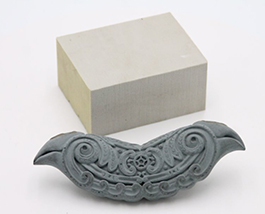Why research and development for custom hardware is expensive
The old and new schools for creating patterns and molds - part 2
Your design skill set and your preference for digital versus free hand designing may influence your choice when it comes to deciding how to create the pattern or file for casting.
Whichever road you take the research and development (R&D) costs will be significant. The R&D costs are often misunderstood, and many consumers have a hard time accepting that the pattern development can run into the thousands depending on the size and intricacy of the design. This cost is on top of the cost incurred in the design process (part 1), so perhaps we are stating the obvious when we state that custom, one of a kind door hardware, is inherently expensive.
Choice of medium for pattern making.
Regardless of whether the design is digital or old school and made with pencil and paper you should be able to use the same mediums when creating your pattern for use in investment casting or sand castings. If you have the budget and are developing a piece for high volume production, then die casting or 3D printing may be good options and may not require a pattern to be made. While die casting and 3D printing do not require a physical pattern, they depend on the design to be made with CAD/CAM software or comparable software that can capture the exact measurements and topography details of your design so that a virtual pattern can be created.
Mediums for Physical Patterns
The pattern for investment casting can be made from any medium that is both strong and non-permeable or that can be made strong by firing in a kiln. Your choice of medium will depend on your manual skills, can you carve or create a design in modelling clay? The choice will also depend on how dense the detail and undercuts are in your design, does the design have a lot of detail or is the design for a smooth piece with the detail confined to the edges? Our patterns are always made in a reductive way by carving or machining rather than by the additive clay modelling method.
Mediums for carving or machining
Rigged foam –
High density rigid polyurethane foam comes in a variety of sheet sizes, thickness, and density. We typically use a medium 15lb per ft density. It can be machined on a bandsaw, turned on a lathe or used with cutting routers. It is ideal for moderately detailed patterns but it’s lack of tensile strength and brittle nature make it less useful for very detailed or large patterns.
Basswood & other woods
Basswood is stronger than rigged foam and finer details such as leaf ends or fingers tips that would be to fragile and brittle if rendered in foam are easy to create in this close-grained soft wood. Patterns created in basswood and foam need to be sealed with a paint primer or other non-permeable layer that act as a barrier to protect the pattern from liquid damage that may occur during mold making.
Blue jewelers’ wax
There are many types of wax available in block and sheet form that can be machined or carved to create a pattern, but we typically use a blue hard wax and pattern making.





